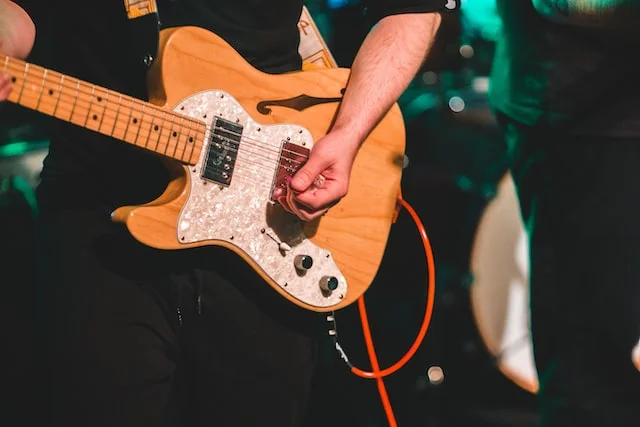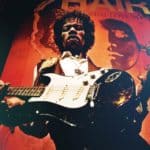When writing, we can divide people into three categories: right-dominant, left-dominant, or ambidextrous.
That is to say, depending on the dominant hand, one will write with one better than the other.
However, this rule applies to other areas of life. For example, playing guitar.
Whether you are right-handed or left-handed plays a significant role at the time of creating music.
After all, the instrument’s position changes to suit one dominant hand.
As a general rule, the dominant hand will be the plucking one. Nonetheless, this is not always the case, since other factors need to be taken into consideration.
We’ll discuss such factors below. For now, let’s focus on the key differences between right-handed and left-handed guitars.
Right-handed guitars and left-handed guitars differ in positions: the thicker string and the fretboard inlays are on the left side on right-handed guitars and the other way around on left-handed guitars. Also, right-handed acoustics have their pickguards on the right side and left-handed ones on the left.
Let’s see these characteristics in a more detailed way.
Next time you go to a music store, you will spot the guitar position immediately.
1. Reversed string order
Strings are reversed to suit the musician’s comfort.
Guitars have the thickest string on top of the fretboard (that is, the closest to the guitarist’s face when in playing position). Meanwhile, the thinnest string remains at the bottom of the fretboard (closest to the player’s leg).
When changing the guitar’s position (switching from right to left, for instance), the strings, logically, switch order.
That way, the thinnest string would be closer to the player’s head, and the thickest next to the legs.
So, left-handed guitars have the order changed. For example, if you were facing the guitar, the thickest string would be on the right side, instead of the left side, and the other way around for right-handed guitars.
2. Pickguard
The pickguard’s function is to avoid scratching the guitar finish with the pick or nails.
Thus, it’s not strange to find the pickguard decides whether a guitar is right-handed or left-handed.
You’ll notice it at first sight.
A right-handed guitar has the pickguard on the right and a left-handed guitar on the left side.
Consider that not every guitar has a pickguard, so you might as well check on other characteristics.
3. Nut
The nut is in charge of holding the string in the right position.
Although you won’t notice any difference, at first sight, the same rule of string thickness applies here as well.
In other words, if the thickest slot is on the left side of the guitar, then that’s a right-handed guitar (and the other way around, of course).
It’s worth pointing out that in certain guitars this will be nearly impossible to notice.
It always depends on the model, and on how close you inspect the nut.
4. Fretboard Inlays
Guitars have little white dots on one of the sides of their fretboards. These dots guide the player and help them know which fret they are playing on.
Naturally, the inlays will be on the side that is closest to the player’s head. That is the one side nearest the sixth string (or fourth string, if it’s a bass guitar).
So, a left-handed guitar will have the dots on the right side, and the other way around for a right. handed guitar.
5. Saddle
For acoustic guitars, it’s a good idea to check the saddle’s angle.
On regular right-handed guitars, the saddle is angled in a specific way that leaves the thickest string as the longest, and the thinnest as the shorter.
Once again, if this is the other way around, then we are talking about a left-handed guitar.
How to know if you need a left-handed or right-handed guitar?
The best approach is always to try a guitar out.
Certain left-handed people have learned to play guitar the right-handed way (and in some unique cases, the other way around).
Thus, the best way to find it out is simply by trying to play a standard guitar and checking whether you’re feeling comfortable or not.
Changes are, that if you are a natural-born left-handed, then you’ll most probably need a left-handed guitar. Conversely, if you are right-hand dominant, then a right-handed guitar will be the choice for you.
However, this is not always the case. Ask a friend or family member to lend you their guitar, then see how you manage with it.
Although chords are made with the left hand (in right-handed people), the plucking hand is the dominant one.
So, pay special attention to that hand (the plucking/picking one), instead of the fretting one when practicing for the very first time. After that, you’ll be able to decide which guitar to choose.
Are left-handed guitars harder to find?
More often than not, left-handed guitars tend to be a minority compared to their counterparts.
Try it and check it for yourself. Go to your nearest guitar store and check the showcases.
You’ll probably find little to no left-handed guitars at first sight.
Sure, most guitar stores sell left-handed instruments, but again, they aren’t abundant at all.
Now, right-handed guitars are more common than left-handed ones. But why’s that?
Well, there are two key factors to consider, one correlating with the other.
First of all, left-handed guitarists are a minority. It’s said that left-handed people comprise approximately 8-15% of the world’s population.
That’s too small of a number!
The second factor to take into account is manufacturing cost.
Guitars, like most products in the world, are built in mass production.
Since left-handed guitarists are more scarce than right-handed ones, the number of left-hand guitars made will be drastically smaller.
All in all, it’s more economical to produce goods in bigger quantities. On the contrary, building per unit (or in small bunches) will result in a higher cost-
And remember, no company’s willing to lose too much money on cost production. So, what’s the point of manufacturing thousands of units if only some hundreds will be able to pay for them?
Not to mention, many left-handed musicians don’t even bother in buying a special guitar at all.
There are other ways in which left-handed people can play right-handed guitars.
We’ll explain them below in a more detailed way. But all in all, that only makes these guitars even harder to find.
Are left-handed guitars more expensive?
Continuing with the logic discussed in the previous paragraph, left-handed guitars are in short supply.
As a result, one needs to spend more time and money when crafting these instruments.
Consequently, if it’s more expensive to manufacture, then it’s more expensive to buy due to the additional expense.
Bear in mind that building a left-handed guitar requires focusing on different positions for the pickups, pickguards, nuts, and bridge. All those details demand too much time, which consequently, demands more money in return.
So, long story short: Yes, left-handed guitars are more expensive.
Alternatives to getting a left-handed guitar
Being left-handed doesn’t mean you need to play with a left-handed guitar.
Some left-hand dominants have learned to play guitar with certain alternative forms.
Arguably, the most common approach is playing the guitar upside down.
Simply take a right-handed guitar and play it as a left-handed one: with the fretting hand being the right one, and the plucking one being the right hand.
Consider that the strings will be upside down as well.
However, you can do the same but this time re-stringing it (as we explained before).
When you play an upside-down guitar, the thickest string (6th string; E standard) will be on the position of the first string (thinnest string, e standard).
By re-stringing it, you keep the strings in the same order as any other guitar, with the thinnest string being at the bottom and the thickest one on the top of the fretboard.
Lastly, you may simply try playing a regular guitar as a regular right-handed person. Certain left dominants can master a guitar the right-handed way.
Who knows. You may be one of those.

Hello there, my name is Ramiro and I’ve been playing guitar for almost 20 years. I’m obsessed with everything gear-related and I thought it might be worth sharing it. From guitars, pedals, amps, and synths to studio gear and production tips, I hope you find what I post here useful, and I’ll try my best to keep it entertaining also.





